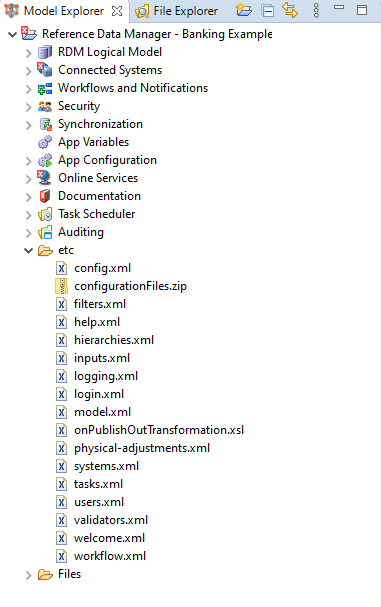Exploring RDM Example Project
The RDM model project contains a set of nodes for configuring the RDM solution:

RDM Logical Model
The RDM Logical Model node defines all configuration related to the reference data itself, its entities, the relationships and the different ways to categorize and organize reference data for usage.
The data model supports a virtually unlimited number of tables and relationships. Basic functions for data modeling involve adding, editing, and deleting new entities, defining entity attributes and parameters, and establishing relationships between entities.
As an essential part of RDM metadata, complex multi-level hierarchies can be created in the data model. The types of hierarchies supported include balanced, unbalanced, and recursive.
The principal components of the RDM logical model are domains (data types), tables, and relationships. See Creating the RDM Data Model.
Auxiliary components—Views, Hierarchies, Categories, and Data sets—allow you to use tables (or specific attributes) to create custom data views or organize tables into categories and hierarchies. See Creating Additional Reference Data Views.
Connected Systems
The Connected Systems node is where you add databases and servers to import and export data to and from RDM.
The node has the following subnodes:
-
Databases is where you add connections to external databases with which you want to synchronize your RDM repository. You also create a data model of tables you want to synchronize with RDM tables and map the attributes of one to the other. See Adding Databases Synchronized with RDM.
-
Servers is where you add connections to remote servers. These are used for file transfers with reference data for your data imports and exports. See Adding Remote Servers for File Transfers.
Workflow Configuration
Workflow Configuration is where you define your change approval workflows.
The node has the following subnodes:
-
Tables is where you set up table-specific workflows (see Configuring RDM Workflows) and action-triggered email notifications (see configuration:configuring-rdm-email-notifications.adoc).
-
Statuses is where you define custom logical states between which records participating in workflows move.
-
Emails is where you create email templates to be used for per-table record change notifications and workflows and summary notifications. See configuration:creating-rdm-email-templates.adoc.
-
Summary Notifications is where you assign email templates to notifications triggered by actions simultaneously performed on multiple records. See configuration:configuring-rdm-email-notifications.adoc.
Synchronization
Synchronization makes it possible to set up imports and exports to text files, synchronization with external databases, and web service configurations for writing and reading data from RDM. See Synchronization.
App Variables
App Variables is where you set up various web application and data model variables, like database type used, web application GUI language, generated primary key attribute name, and others. See App Variables.
App Configuration
App Configuration is used to generate a ZIP file with configuration files to deploy to the RDM web application.
It also contains links to files in the etc folder.
See How to Deploy an RDM Web App Configuration.
Documentation
Documentation contains technical and business documentation about the configured data model.
Task Scheduler
Task Scheduler is where you schedule synchronization or batch export tasks. See Scheduling Tasks.
Auditing
Auditing is where you configure auditing of actions made by web application users. See Setting up Auditing.
etc
The etc folder contains the configuration XML files and the resulting ZIP generated by the App Configuration node.

Files
The Files folder contains a data folder with generated plans, workflow and scheduler files, and HTML documentation files. In addition, we recommend using this folder for any other files, like CSV or TXT batch load data files, or custom validation and enrichment components.
Was this page useful?
